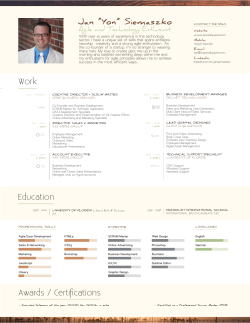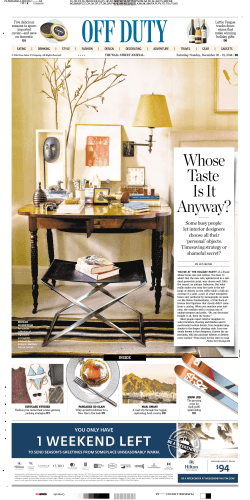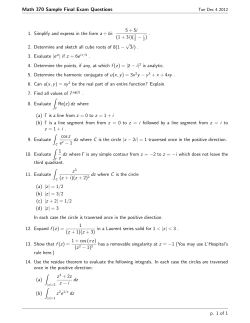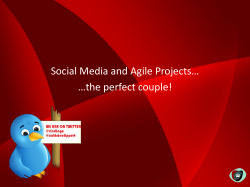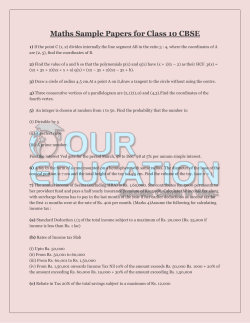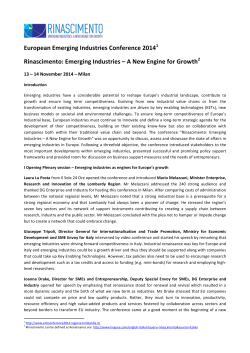
Horizon III Design The Art and Science of an Emerging Paradigm
Horizon III Design The Art and Science of an Emerging Paradigm Evan Leonard, Bill Zybach Opening The language and thinking behind organisational change appears to belong largely to a mechanistic perspective (Capra, 2003). If managers of the health system wish to [achieve their goal they] may need to shift from optimising health care delivery in a mechanistic model to optimising health care workers in a living system. ..the “machine” is made up of people and not inanimate parts. Research on new Medical Practice Teams under Rural Health Reform in South Africa: Education for Health, Volume 21, Issue 2, 2008 Agenda 1. The Art: • • Design Horizons I, II & III Our role as designers? 2. The Science: developmental “drive” 3. The Practice: Experiments in an Emerging Paradigm • • • District of Columbia Progress Software Midwest Health Care System 4. Unanswered Questions The Art Our Role as Designers Introduction to Design Horizons Horizo n I. Traditional and Core Galbraith Star II. New but Proven ODF 7 Step III. Emerging - R&D Who Leaders/Experts/Function al responsibility of HR or Strategy Function Design Teams/Sponsors/Stakehol ders Whole System Engagement/Leadership responsibility Everyone owns the design process – and it is built into the operating model, shared leadership What Incremental Analysis, Part of Strategic Planning – focus on maintaining the status quo Continuous Improvement and Exploration, An initiative to address performance issues – extend status quo Disruptive Imagination, Not an initiative designed into operating systems – demise of status quo When Event based or annually Driven by strategic issues or crisis Built into daily and regular operations How Autocratic Drive: Individual or Small Group Benevolent Desire: Sponsors, Champions, Cross Section/Conference Models/Whole Intrinsic Tensions: Integral aspect of individual’s daily, weekly, monthly, quarterly mechanisms Circle Round: What is your “center” on this spectrum? The majority of my work has been in Horizon ______ and personally I have felt ______ Table Discussion: What role, if any, could we, the Organization Design Forum community, play as designers in the evolutionary growth of our customer systems? A premise that we would like you to move toward or away from is: “We, as a community of organization designers, have an intrinsic role to draw the systems we work with up to higher Horizons.” The Science The Emerging Awareness of What is Driving New Perspectives about Design Humans have an innate impulse for meaning-making This impulse creates a consistent way of being, doing & thinking This impulse unfolds in consistent stages Ken Wilber Cook-Greuter Torbert Preconventional 2: Impulsive 2/3: Self-defensive Impulsive Opportunist Conventional 3: Conformist 3/4: Self-conscious 4: Conscientious Diplomat Expert/Technician Achiever Postconventional / Systems view 4/5: Individualist 5: Autonomous 5/6: Construct-aware Individualist Strategist Alchemist Unitive view 6: Unitive Ironist Piaget Concrete operations Abstract operations Formal operations Cook-Greuter, 2005 We may fluctuate between the stages Neo-mammalian (Human) Mammalian Reptilian (basic fear an threat circuitry) At rest, energy focuses in upper-loop Perceived threat focuses energy on lower-loop In a consistent environment the brain naturally develops, one layer at at time Reptilian Mammalian Neo-mammalian (Human) from Magical Child Matures (New York: E. P. Dutton, 1985) Prolonged exposure to threat permanently alters the brain From The Biology of Transendence (Rochester: J. P. Pearce, 2002) More about "Threat" Not just physical "fear": SCARF model, David Rock, 2009 Summary from http://www.covision.com/blog/ Table Discussion: What traditional design practices work against this developmental drive? Discuss at your table for 5 minutes The Practice Experiments in an Emerging Paradigm Case Study: District of Columbia Context: • Emotionally Intellegent Leader • Results Only Work Environment • “Drive” • Holacracy Pillar I: Pillar II: Pillar III: Why Holacracy was the Differentiator • Splits Governance and daily or routine operations, and • Builds-in rather than bolts-on “real time” redesign which is owned by all members of the organization Real-time Organizational Governance • Focuses on any tensions in the system • Everyone is a full member of a Governance Circle • Rigorous process (Integrated Decision-Making) for governance to ensure optimal participation • Only outcomes are Roles and Accountabilities, no action planning or problem solving • The goal is a workable decision – not the “best” • Any issue can be revisited at anytime Holacracy: Tensions Drive Design Holacracy Publishing Board IT Finance General Srvcs Logistic s General Company Circle Product Dev BusDev Mrktng Srvc Delivery Events Holacracy Marketing Affiliate Partners Media General Company Circle Key Service Lines Design Client Project Team Client Project Team Financ e Legal Ideation Delivery Group A Service Delivery Circle Project Mgt Account Mgt Method Client Project Team Client Project Team Staffin g HR Delivery Group B Platform DC Holacracy Outcomes – 180 Days • Began with 3 months of cultural alignment (Enlightened Leadership and ROWE) • 3 day Holacracy implementation for team of 18 • Went from the “worst place to work to one of the best and highest performing, and highest customer satisfaction groups in OCTO in 180 days • 25 % reduction in Staff (Didn’t fit) • Production increased 20% • Cost to customer reduced from 2.6 Million to 2.1Million annually Case Study II: Progress Software Scrum Overview The Scrum Master • Accountabilities – Responsible for enacting Scrum values, practices & rules and ensuring that the Team adheres to them – Make impediments visible and remove them – Ensure that the team is fully functional and productive – Enable close cooperation across all roles and functions – Shield the team from external interferences – Represent management to the project – Coach the team – Facilitate Scrum ceremonies (Planning, Daily Scrum, Review & Retrospective) • Limitations – May be a Team Member but NOT the Product Owner – Cannot manage the team since Scrum teams are supposed to be self organizing Progress Software collaborative ScrumMaster definition, 2011 Collaborative Governance • Development process itself was defined (and continues to be defined) using Scrum itself • Backlog of existing “tensions” • An executive played the Product Owner role I played the “ScrumMaster” role • Small groups developed proposals • Larger group adopted them • ScrumMasters of development teams feed new tensions into the Backlog as they emerge Case Study III Accelerated Solutions Solving Business Complexities with the Decision Accelerator Work Innovation Networks (WIN) Stu Winby's (Sapience) A structured framework and network within which: • work units/teams learn about research/innovations and best practice, • apply adaptive principles and practices and quality methods, • exchange their experiences of development, implementation, and making improvements. WIN utilizes processes such as the Decision Accelerator to accelerate innovation adoption and rapid transformation. Decision Accelerator (DA) Stu Winby's (Sapience) • A creative, knowledge rich, technology enabled, highly collaborative environment where clients participate in work-sessions • A work-session is a process to create strategic solutions and tactical plans to solve complex issues. • DA’s drive organization design by resolving tensions created by the existing system WIN/DA Outcome: Midwest Health Care System moves from National Rank of mid 20’s to #1 in 3 years (Supplanting Mayo Clinic at #1) Unanswered Questions Table Discussion: What else in Horizon III is emerging, and what challenges limit its growth? Discuss at your table for 5 minutes Circle Round: Where is ODF’s “center” on this spectrum? Where do we want it to be, and what are the implications for the next generation, the “Facebook Generation”? Summary 1. The Art: • • Design Horizons I, II & III Our role as designers? 2. The Science: developmental “drive” 3. The Practice: Experiments in an Emerging Paradigm • • • District of Columbia Progress Software Midwest Health Care System 4. Unanswered Questions References Cook-Greuter, 2005 http://areas.fba.ul.pt/jpeneda/Cook-Greuter.pdf Rock, 2009 http://www.davidrock.net/files/Neuroscience-of-engagement.pdf Pink, 2009 http://www.amazon.com/Drive-Surprising-Truth-AboutMotivates/dp/1594488843 John P Kotter, Corporate Culture and Performance http://kotterinternational.com/ How to Manage Organisational Change and Create Practice Teams: Education for Health, Volume 21, Issue 2, 2008 www.educationforhealth.net/publishedarticles/article_print_132.pdf
© Copyright 2025

